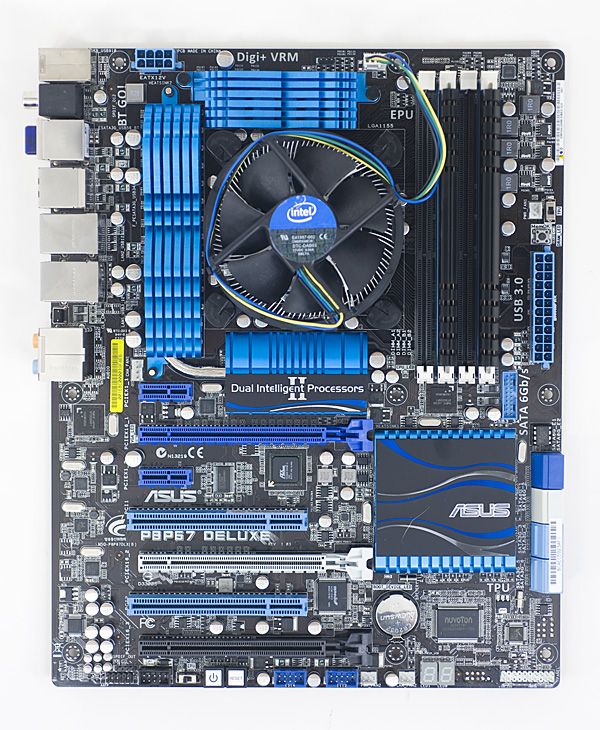The Sandy Bridge Review: Intel Core i7-2600K, i5-2500K and Core i3-2100 Tested
by Anand Lal Shimpi on January 3, 2011 12:01 AM ESTUEFI Support: 3TB Drives & Mouse Support Pre-Boot
Remember the mountain of issues I had trying to get Seagate’s 3TB HDD to work as a boot drive in my X58 system? A couple of weeks ago Intel released version 10.1 of its storage drivers, which added software support for drives larger than 2.2TB. That’s one piece of the puzzle. With Sandy Bridge, many motherboard manufacturers are moving to UEFI instead of traditional 32-bit PC BIOSes. Combine that with a GPT partition and your new Sandy Bridge system should have no problems booting to and accessing 3TB drives made of a single partition.

ASUS' entire SNB lineup is UEFI enabled
ASUS sent over a couple of its 6-series motherboards which boast a custom skinned UEFI implementation. You get all of the functionality of a traditional BIOS but with a GUI, and yes, there’s full mouse support.
You’re either going to love or hate the new UEFI GUIs. They do take a little time to get used to but pretty much everything is where you’d expect it to be. Navigating with the mouse can be quicker than the keyboardin some situations and slower in others. Thankfully the interface, at least ASUS’, is pretty quick. There’s scroll wheel support although no draggable scroll bars, which makes quickly scrolling a little frustrating.
Unlike P55, you can set your SATA controller to compatible/legacy IDE mode. This is something you could do on X58 but not on P55. It’s useful for running HDDERASE to secure erase your SSD for example. If you do want to use HDDERASE on a 6-series motherboard you’ll need to first run HDDERASE4 to disable the UEFI initiated security on your drive and then run HDDERASE3 to secure erase it.
The biggest improvement to me honestly is POST time. Below is a quick comparison of time from power on to the Starting Windows screen. I’m using the exact same hardware in all three cases, just varying motherboard/CPU:
| Intel P67 | Intel P55 | Intel X58 | |
| Time from Power on to Boot Loader | 22.4 seconds | 29.4 seconds | 29.3 seconds |










283 Comments
View All Comments
dansus - Saturday, February 19, 2011 - link
Looking at the results of Quick Sync transcoding, the results are very interesting.But which h264 encoder is ArcSoft using, im guessing its Mainconcept, would like to compare QS with x264 to be sure of the results.
In future, be nice to see the original frame to compare with too. Without the original, comparing just the encoded frames means little.
7eventh - Sunday, February 20, 2011 - link
Looking at cbscores.com (using the actual Cinebench 11.5) the 2600K is not THAT glorious at rendring-speed ... Why did you use Cinebench 10?pshen7 - Tuesday, February 22, 2011 - link
Who in the world named it Sandy Bridge? And Cougar Point is no better. They need a better marketing department. Seriously.Peter Shen, Koowie.com
zzzxtreme - Thursday, March 3, 2011 - link
does that mean I can't install windows XP/DOS on UEFI motherboards?dwade123 - Tuesday, March 8, 2011 - link
Intel i3 2100 is so underrated. It beats AMD's fastest's 6 core and older i7 Quadcores in many games and is only a little slower in other areas.Wouggie - Tuesday, March 15, 2011 - link
With an even improved i7990 Extreme now out, with a base speed of 3.46 GHz, which would be the better choice, considering I am going to using a dedicated graphics card Nvidia Quadro 4000.Also. what do you see on the horizon for three channel motherboards with more than 2 SATA lll 6 Gb/s connectors?
georgevt - Sunday, March 27, 2011 - link
The benchmarks against the AMD processors are useless. All the compare is core-to-core performance (4 core to 4 core). You should be comparing is comparably priced processors/systems. For example, the 6-core AMD 1090T costs a hundred dollars less than the i7 2600 at newegg.com, yet your benchmarks fail to provide any comparative benchmarks. It's quite possible that for some applications, that the 6-core AMD may perform better than the more expensive i4-core 7 processors in your benchmarks.scurrier - Friday, April 1, 2011 - link
Anand says, "frequency domain (how often pixels of a certain color appear)," but this definition of the frequency domain is incorrect. Frequency domain in the case of video is a 2 dimensional discrete cosine transform of the frame. It is not a count of pixels like a histogram (binning) or anything.aka_Warlock - Saturday, April 30, 2011 - link
Would be nice to see som test of how much of a performance difference lacking VT-d has on th CPU?AbdurRauf - Monday, May 2, 2011 - link
Does the QuickSync handle uprezing or only transcoding? Have you looked at the new WinFast HPVC1111 SpursEnginex4 and compared it to Quicksync, Cuda and Stream encoding and uprezing?